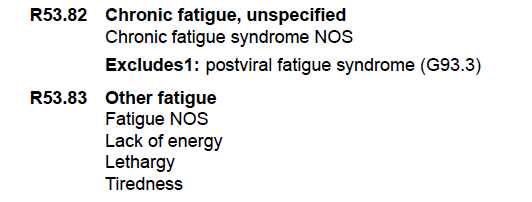Dx Revision Watch
Suzy Chapman Owner of Dx Revision Watch
- Messages
- 3,061
- Location
- UK
Location of CFS in WHO's ICD-10 compared with the U.S. "clinical modification" ICD-10-CM, which is the responsibility of NCHS:
I've edited this screenshot into an earlier post in this thread but if anyone needs a screenshot showing the WHO's ICD-10 coding of PVFS and (B)ME, with CFS displaying as Index term coded to G93.3, here is an image from the online ICD-10 Version: 2015:

(Index term designated by orange symbol.)
ICD-10-CM
This is the current location of CFS (as CFS NOS) in the U.S. specific ICD-10-CM which is scheduled for implementation on October 1, 2015:
ICD-10-CM FY 2015 Release:
http://www.cdc.gov/nchs/icd/icd10cm.htm
Chapter 18
Symptoms, signs and abnormal clinical and laboratory findings, not elsewhere classified (R00-R99)
(...)

And here's a screenshot from ICD-10-CM Chapter 6, showing an Excludes1 for CFS NOS:

I've edited this screenshot into an earlier post in this thread but if anyone needs a screenshot showing the WHO's ICD-10 coding of PVFS and (B)ME, with CFS displaying as Index term coded to G93.3, here is an image from the online ICD-10 Version: 2015:

(Index term designated by orange symbol.)
ICD-10-CM
This is the current location of CFS (as CFS NOS) in the U.S. specific ICD-10-CM which is scheduled for implementation on October 1, 2015:
ICD-10-CM FY 2015 Release:
http://www.cdc.gov/nchs/icd/icd10cm.htm
Chapter 18
Symptoms, signs and abnormal clinical and laboratory findings, not elsewhere classified (R00-R99)
(...)

And here's a screenshot from ICD-10-CM Chapter 6, showing an Excludes1 for CFS NOS:

Last edited:
